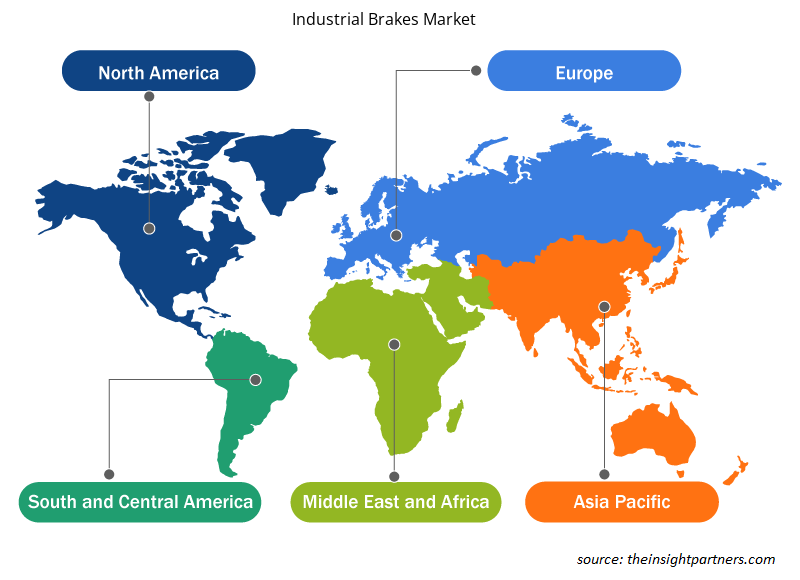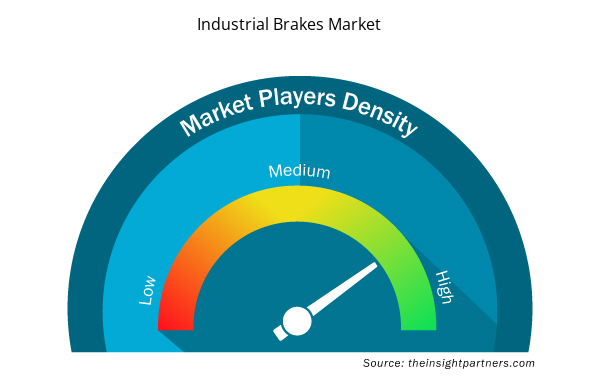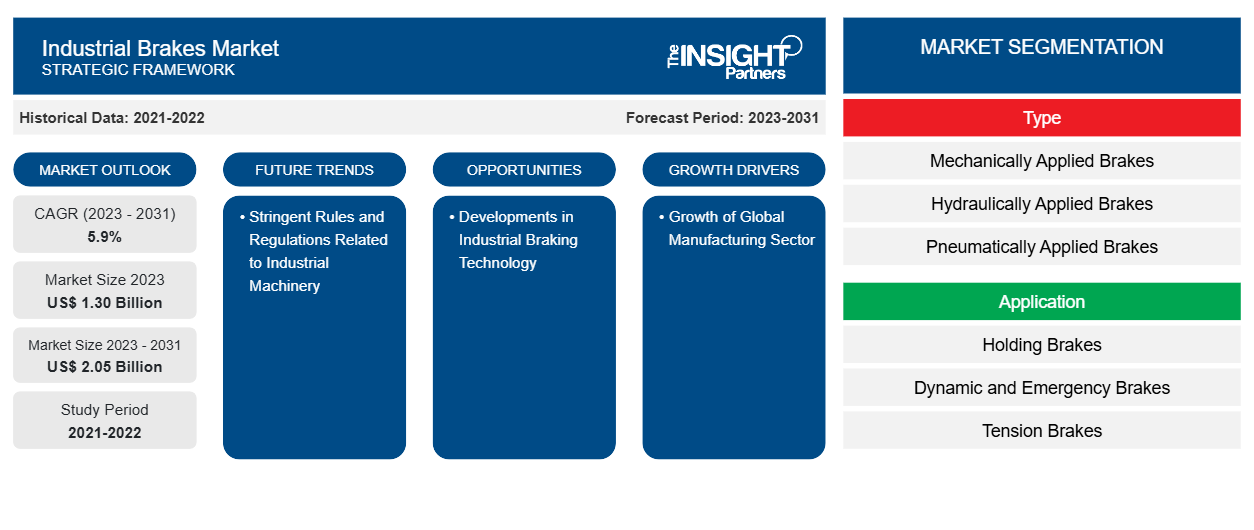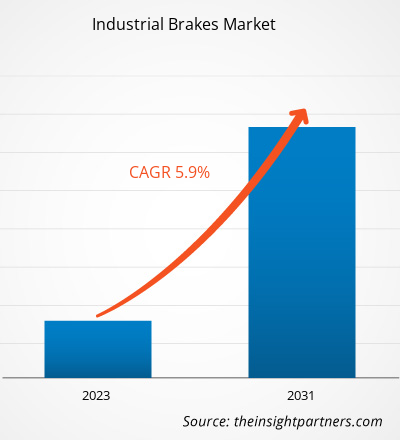工业制动器市场规模预计将从 2023 年的 13 亿美元增至 2031 年的 20.5 亿美元。预计 2023-2031 年市场复合年增长率为 5.9%。CAGR of 5.9% in 2023–2031.
工业制动器是一种摩擦装置,用于停止旋转惯性负载或将部件保持在固定位置。在大多数情况下,惯性负载是由许多必须停止的旋转部件引起的。为了减慢速度,它们将两个表面之间摩擦产生的动能转化为热量。工业制动器与汽车制动器的不同之处在于它们用于各种工业机器。工业制动器适用于全天候环境,由于运动部件较少,因此需要的维护较少,并且易于针对各种应用进行修改。在预测期内,所有这些原因都可能推动全球对工业制动器的需求。
工业制动器具有诸多优势,其中之一就是所需零件和备件数量少。其他优势包括一体式设计便于清洁、工业制动器使用寿命长,投资回报率高,以及能够在恶劣环境下工作。此外,工业化进程加快和政府加大对工业部门的投资以促进产量,预计将在预测期内对工业制动器市场产生重大影响。
工业制动器市场分析
全球工业制动器市场生态系统的主要利益相关者包括原材料供应商、工业制动器制造商和最终用户。不同行业制造单位对先进制动器的需求不断增长,这是推动工业制动器需求的主要因素之一。原材料供应商为各种类型的工业制动器提供多种不同的装置,例如机械制动器、液压制动器、气动制动器和电动制动器。除此之外,最终用户使用工业制动器为工业设备提供必要的速度、加速度和减速度,这也进一步影响了对工业制动器的需求。
工业制动器市场概况
工业制动器广泛应用于重型机械和工业车辆制造,如挖掘机、推土机、反铲挖土机、滑移装载机等。工业制动器还用于各种食品加工设备、医疗设备、工业厂房中的液压机械、汽车制造和其他应用。工业制动器市场在亚太地区占有最大份额,这归功于几家中小型制造商和领先企业。亚太地区的一些工业制动器制造商包括 Altra Industrial Motion Corp.、ADVICS CO., LTD.;Akebono Brake Industry Co., Ltd.、AMETEK Inc.、Eaton Corporation plc;Emco Precima Engineering Pvt Ltd. 等。这些制造商为全球各个行业供应工业制动器。
定制此报告以满足您的需求
您可以免费定制任何报告,包括本报告的部分内容、国家级分析、Excel 数据包,以及为初创企业和大学提供优惠和折扣
- 获取此报告的关键市场趋势。这个免费样品将包括数据分析,从市场趋势到估计和预测。
工业制动器市场驱动因素和机遇
全球制造业的增长
自工业革命开始以来,技术进步导致工业生产能力大幅提升;因此,制造业在世界各地呈上升趋势。普华永道 (PwC) 表示,经济增长、劳动力质量、税收政策、监管环境以及运输和能源价格是催化该行业复苏的因素。随着制造业的扩张,包括机械设备供应商在内的相关市场也在蓬勃发展。随着发展中国家新类别消费者的出现,世界各地的制造商可能会拥有巨大的新前景;此外,创新会产生新的需求,从而推动制造单位使用现代设备和系统。
与工业机械相关的严格规则和法规
机器是生产过程中必不可少的,但机器运行过程中的事故可能会导致烧伤、失明和截肢。保护措施、标准化操作程序和全面培训可能有助于确保员工的安全。世界各国政府和组织正在通过在生产设施中实施排放和安全标准来改变其运营方式。职业安全与健康管理局 (OSHA) 在 2018 财年对违反安全标准的罚款总额超过 5000 万美元。因此,美国政府正在制定一项长期监管路线图,以促进制造业的繁荣,提高其对 GDP 的贡献。
工业制动技术的发展
在设计设备系统时,考虑制动系统如何影响后续机器的运行至关重要。故障安全制动器有助于在发生事故、性能故障或电源故障等情况下快速停止机器的运动。各公司还在研究液压释放制动器,这是一种弹簧制动系统,利用液压能量产生可调扭矩。采矿绞车、高架起重机、轧钢系统和其他类似设备对工业制动器的需求很高。此外,仓储、医疗、钢厂和食品加工行业对工业制动器市场具有巨大潜力。各公司正在积极研究具有高允许制动能量、高扭矩和耐磨性的弹簧制动器。例如,工业制动器和离合器的 OEM 和分销商 Kor-Pak 正在为采矿业和制造业开发端到端制动系统。
工业制动器市场报告细分分析
有助于得出工业制动器市场分析的关键部分是温度类型、仓库类型和应用。
- 根据类型,市场分为机械制动器、液压制动器、气动制动器、电动制动器和其他制动器。机械制动器施加力(最常见的是摩擦力)来减慢或停止机器或物体的移动。这种力施加在旋转或线性运动的物体上,例如车轴、轴杆或车轮。机械制动器用于物料搬运、制造和其他动力传输应用,最常用于汽车。为了接合和分离轴,机械制动器通常与机械离合器一起使用。为了减速,摩擦制动器使用粗糙而坚韧的物质(制动衬片),将其收紧或压在运动物体上。摩擦制动会产生大量热量和相当大的噪音,从而降低所涉及的表面积。
- 根据应用,全球工业制动器市场分为保持制动器、动态和紧急制动器以及张力制动器。电机保持制动器负责在电源级关闭时保持电机的位置。保持制动器既不是安全装置也不是维护制动器。这种制动器用于工厂自动化、医疗设备、电梯和自动扶梯、建筑设备、机器人和机床设备。许多公司为各种应用和工业环境提供保持制动器。例如,Vortex Engineering Works 为纺织行业的操作提供弹簧保持制动器。
- 根据垂直行业,市场分为制造业、金属和采矿业、建筑业、发电业、海洋和航运业等。
工业制动器市场份额按地区分析
工业制动器市场报告的地理范围主要分为五个区域:北美、亚太地区、欧洲、中东和非洲以及 SAM。
亚太国家工业部门的持续发展促进了其经济繁荣。这一变化导致了富裕程度的提高、城市化和人口扩张。此外,亚太地区占全球能源消耗的很大一部分,工业部门占该地区能源消耗的大部分。该地区由 58 个经济体组成,拥有世界 60% 以上的人口。根据亚行 2018 年年度报告,其在全球购买力平价国内生产总值 (GDP PPP) 中的份额从 2000 年的 30.1% 增加到 2017 年的 42.6%,中国、日本和印度三个国家占 2017 年该地区总产量的 70% 以上。2014 年,亚太地区的能源总消耗量以全球速度的两倍增长;它消耗了世界总能源供应的 50% 以上,占全球燃料排放量的约 55%。
工业部门的扩张也导致能源消耗和温室气体排放增加。在需要最佳工作条件的企业中使用节能替代品,增加了对各种工业制动器的需求。此外,能源安全的提高、工作场所环境质量的改善以及与能源效率相关的商业前景带来的新就业机会的创造也导致了该地区工业化的增长,从而推动了工业制动器市场的增长。
工业制动器市场区域洞察
Insight Partners 的分析师已详尽解释了预测期内影响工业制动器市场的区域趋势和因素。本节还讨论了北美、欧洲、亚太地区、中东和非洲以及南美和中美洲的工业制动器市场细分和地理位置。

- 获取工业制动器市场的区域特定数据
工业制动器市场报告范围
| 报告属性 | 细节 |
|---|---|
| 2023 年的市场规模 | 13亿美元 |
| 2031 年市场规模 | 20.5亿美元 |
| 全球复合年增长率(2023 - 2031) | 5.9% |
| 史料 | 2021-2022 |
| 预测期 | 2023-2031 |
| 涵盖的领域 | 按类型
|
| 覆盖地区和国家 | 北美
|
| 市场领导者和主要公司简介 |
|
工业制动器市场参与者密度:了解其对业务动态的影响
工业制动器市场正在快速增长,这得益于终端用户需求的不断增长,而这些需求又源于消费者偏好的不断变化、技术进步以及对产品优势的认识不断提高等因素。随着需求的增加,企业正在扩大其产品范围,进行创新以满足消费者的需求,并利用新兴趋势,从而进一步推动市场增长。
市场参与者密度是指在特定市场或行业内运营的企业或公司的分布情况。它表明在给定市场空间中,相对于其规模或总市场价值,有多少竞争对手(市场参与者)存在。
在工业制动器市场运营的主要公司有:
- 曙光制动工业株式会社
- Altra 工业运动公司
- 阿美特克公司
- Antec SAU 新技术应用
- Dellner Bubenzer 德国有限公司
- 希利亚德公司
免责声明:上面列出的公司没有按照任何特定顺序排列。

- 了解工业制动器市场顶级关键参与者概况
工业制动器市场新闻和最新发展
工业制动器市场通过收集一手和二手研究后的定性和定量数据进行评估,其中包括重要的公司出版物、协会数据和数据库。以下是市场创新、业务扩展和战略发展情况的列表:
- 2023 年 3 月,印度 TVS Apache Brakes 品牌推出了基于先进技术的电动汽车 ZAP 刹车片。ZAP 是一种制动液,旨在满足用户对电动汽车的需求。它提高了耐腐蚀性,提供了保护,并为电动汽车提供了静音制动。(来源:Eurofins,新闻稿)
工业制动器市场报告范围和交付成果
“工业制动器市场规模和预测(2021-2031)”报告对市场进行了详细的分析,涵盖以下领域:
- 工业制动器市场规模及全球、区域和国家层面所有主要细分市场的预测
- 市场动态,如驱动因素、限制因素和关键机遇
- 工业制动器市场趋势
- 详细的PEST分析和SWOT分析
- 工业制动器市场分析涵盖主要市场趋势、全球和区域框架、主要参与者、法规和最新的市场发展。
- 工业制动器市场行业格局和竞争分析涵盖市场集中度、热图分析、知名参与者和最新发展。
- 详细公司简介
- 历史分析(2 年)、基准年、预测(7 年)及复合年增长率
- PEST 和 SWOT 分析
- 市场规模价值/数量 - 全球、区域、国家
- 行业和竞争格局
- Excel 数据集


- Latent TB Detection Market
- Power Bank Market
- Quantitative Structure-Activity Relationship (QSAR) Market
- Cut Flowers Market
- Asset Integrity Management Market
- Electronic Health Record Market
- Equipment Rental Software Market
- Explosion-Proof Equipment Market
- Small Internal Combustion Engine Market
- Redistribution Layer Material Market

Report Coverage
Revenue forecast, Company Analysis, Industry landscape, Growth factors, and Trends

Segment Covered
This text is related
to segments covered.

Regional Scope
North America, Europe, Asia Pacific, Middle East & Africa, South & Central America

Country Scope
This text is related
to country scope.
常见问题
North America is expected to dominate the industrial brakes market in 2023.
The growth of the global manufacturing sector drives market growth.
Stringent rules and regulations related to industrial machinery driving the market trend.
Akebono Brake Industry Co., Ltd., Altra Industrial Motion Corporation, Ametek Inc., Aplicación Nuevas Tecnologías Antec SAU, Dellner Bubenzer Germany GmbH, Hilliard Corporation, Kobelt Manufacturing Co. Ltd., KOR-PAK Corporation, Ringspann GmbH and Tolomatic, Inc
Industrial brakes market size is projected to reach US$ 2.05 billion by 2031 from US$ 1.30 billion in 2023.
The market is expected to register a CAGR of 5.9% in 2023–2031.
Trends and growth analysis reports related to Manufacturing and Construction : READ MORE..
The Insight Partners performs research in 4 major stages: Data Collection & Secondary Research, Primary Research, Data Analysis and Data Triangulation & Final Review.
- Data Collection and Secondary Research:
As a market research and consulting firm operating from a decade, we have published and advised several client across the globe. First step for any study will start with an assessment of currently available data and insights from existing reports. Further, historical and current market information is collected from Investor Presentations, Annual Reports, SEC Filings, etc., and other information related to company’s performance and market positioning are gathered from Paid Databases (Factiva, Hoovers, and Reuters) and various other publications available in public domain.
Several associations trade associates, technical forums, institutes, societies and organization are accessed to gain technical as well as market related insights through their publications such as research papers, blogs and press releases related to the studies are referred to get cues about the market. Further, white papers, journals, magazines, and other news articles published in last 3 years are scrutinized and analyzed to understand the current market trends.
- Primary Research:
The primarily interview analysis comprise of data obtained from industry participants interview and answers to survey questions gathered by in-house primary team.
For primary research, interviews are conducted with industry experts/CEOs/Marketing Managers/VPs/Subject Matter Experts from both demand and supply side to get a 360-degree view of the market. The primary team conducts several interviews based on the complexity of the markets to understand the various market trends and dynamics which makes research more credible and precise.
A typical research interview fulfils the following functions:
- Provides first-hand information on the market size, market trends, growth trends, competitive landscape, and outlook
- Validates and strengthens in-house secondary research findings
- Develops the analysis team’s expertise and market understanding
Primary research involves email interactions and telephone interviews for each market, category, segment, and sub-segment across geographies. The participants who typically take part in such a process include, but are not limited to:
- Industry participants: VPs, business development managers, market intelligence managers and national sales managers
- Outside experts: Valuation experts, research analysts and key opinion leaders specializing in the electronics and semiconductor industry.
Below is the breakup of our primary respondents by company, designation, and region:

Once we receive the confirmation from primary research sources or primary respondents, we finalize the base year market estimation and forecast the data as per the macroeconomic and microeconomic factors assessed during data collection.
- Data Analysis:
Once data is validated through both secondary as well as primary respondents, we finalize the market estimations by hypothesis formulation and factor analysis at regional and country level.
- Macro-Economic Factor Analysis:
We analyse macroeconomic indicators such the gross domestic product (GDP), increase in the demand for goods and services across industries, technological advancement, regional economic growth, governmental policies, the influence of COVID-19, PEST analysis, and other aspects. This analysis aids in setting benchmarks for various nations/regions and approximating market splits. Additionally, the general trend of the aforementioned components aid in determining the market's development possibilities.
- Country Level Data:
Various factors that are especially aligned to the country are taken into account to determine the market size for a certain area and country, including the presence of vendors, such as headquarters and offices, the country's GDP, demand patterns, and industry growth. To comprehend the market dynamics for the nation, a number of growth variables, inhibitors, application areas, and current market trends are researched. The aforementioned elements aid in determining the country's overall market's growth potential.
- Company Profile:
The “Table of Contents” is formulated by listing and analyzing more than 25 - 30 companies operating in the market ecosystem across geographies. However, we profile only 10 companies as a standard practice in our syndicate reports. These 10 companies comprise leading, emerging, and regional players. Nonetheless, our analysis is not restricted to the 10 listed companies, we also analyze other companies present in the market to develop a holistic view and understand the prevailing trends. The “Company Profiles” section in the report covers key facts, business description, products & services, financial information, SWOT analysis, and key developments. The financial information presented is extracted from the annual reports and official documents of the publicly listed companies. Upon collecting the information for the sections of respective companies, we verify them via various primary sources and then compile the data in respective company profiles. The company level information helps us in deriving the base number as well as in forecasting the market size.
- Developing Base Number:
Aggregation of sales statistics (2020-2022) and macro-economic factor, and other secondary and primary research insights are utilized to arrive at base number and related market shares for 2022. The data gaps are identified in this step and relevant market data is analyzed, collected from paid primary interviews or databases. On finalizing the base year market size, forecasts are developed on the basis of macro-economic, industry and market growth factors and company level analysis.
- Data Triangulation and Final Review:
The market findings and base year market size calculations are validated from supply as well as demand side. Demand side validations are based on macro-economic factor analysis and benchmarks for respective regions and countries. In case of supply side validations, revenues of major companies are estimated (in case not available) based on industry benchmark, approximate number of employees, product portfolio, and primary interviews revenues are gathered. Further revenue from target product/service segment is assessed to avoid overshooting of market statistics. In case of heavy deviations between supply and demand side values, all thes steps are repeated to achieve synchronization.
We follow an iterative model, wherein we share our research findings with Subject Matter Experts (SME’s) and Key Opinion Leaders (KOLs) until consensus view of the market is not formulated – this model negates any drastic deviation in the opinions of experts. Only validated and universally acceptable research findings are quoted in our reports.
We have important check points that we use to validate our research findings – which we call – data triangulation, where we validate the information, we generate from secondary sources with primary interviews and then we re-validate with our internal data bases and Subject matter experts. This comprehensive model enables us to deliver high quality, reliable data in shortest possible time.


 获取此报告的免费样本
获取此报告的免费样本